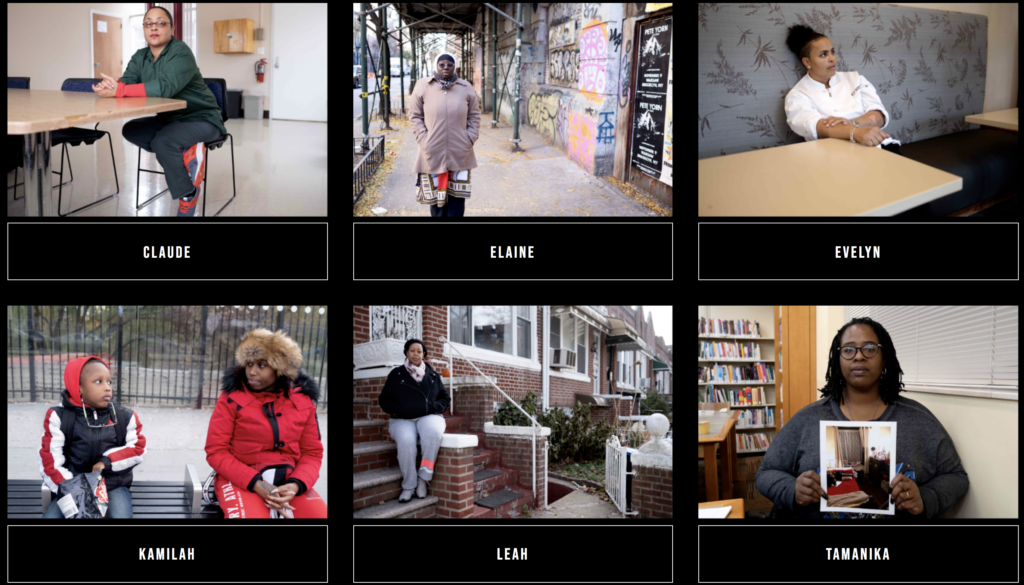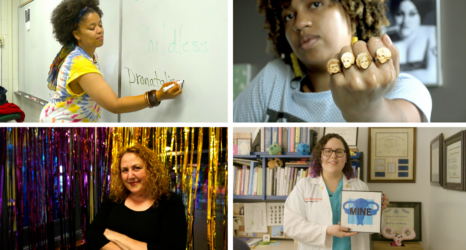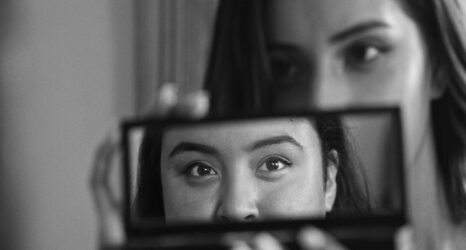The Feminist Lens series offers an inside look into the world of film-making and media production through conversations between women in the film, television and digital media industry and Aviva Dove-Viebahn, a Ms. scholar and professor who writes about gender and race in popular culture.
At the end of the January, I had the privilege of attending Sundance Film Festival, which now also includes multimedia work in addition to film and television.
Easily the most remarkable exhibition was “Still Here“—a striking and impressive multimedia installation.
Produced by Al Jazeera Contrast, and created by Zahra Rasool and Sarah Springer, “Still Here” meditates on the prison industrial complex, urban gentrification and the experience of formerly incarcerated women.
The photographs (taken by Sara Bennett), chronicle the experiences of six women who have returned home after anywhere from two to twenty-five years in prison.

One woman profiled, Claude, went to prison when she was 19, only to emerge at 44 into a very different world.
In addition to the photographs and snippets of interviews with these real women, the immersive AR/VR components of “Still Here” allow viewers to walk in the shoes of a fictional composite character, Jasmine, who returns to her changed Harlem neighborhood after being incarcerated for fifteen years.
In late February, I spoke to creator Zahra Rasool and VR 360 writer and director Naima Ramos-Chapman to hear a bit more about their inspiration for this project and what they hope audiences and the women whom they’re representing will take away from the installation.
Aviva Dove-Viebahn: Zahra, could you start by talking about how you came to this project?
Zahra Rasool: I went to university to do investigative journalism—started my career in the field producing documentaries for TV and was introduced to tech and storytelling journalism by chance. I was doing my startup for a few years and then working for a company that created immersive experiences. It was a field that I was not well versed in at all.
So, I just launched on the job and really enjoyed it because, especially within the storytelling “editorial journalism” space, most experiences are still new. Four years ago, when I started working on that, people were just starting to get into it. And while I really enjoyed the creative aspect of trial and error—figuring out what works, what doesn’t work, how do you use the tech—I was also pretty frustrated because it felt like the people who had access to the tools and the knowledge of how to use the tools were very limited.
But the stories that were being told using this immersive format were about people, communities and places that were marginalized or undercover.
One of the novelties with immersive experiences is that you’re going to take people to a location they would not be able to go. Or they can experience something that they don’t have access to. So, I was raising solutions, but felt like the medium somehow ended up being even more exploitative because of who has the power.
When this opportunity came up, we were looking to create an innovation studio, and I told them I’d come onboard if I could have control over editorial, if I could actually hire a team that’s working with me instead of defying the kind of immersive experience we’ve created here.
So, the project in many ways was the combination of my experiences within the industry where I feel we wanted to talk about a subject that’s really important to young Americans and tell it in a way that was different. To show how we can create this work properly and more inclusively and more authentically. When we decided we wanted to tell the story about incarceration we knew that we wanted to collaborate with the people whose stories we were telling.
ADV: Naima, how about you? How did you get involved with Still Here?
Naima Ramos-Chapman: Zahra reached out to me and had this idea about the character Jasmine, coming back home after being incarcerated years before. I was drawn in because I felt very connected to [the story]; unfortunately, a lot of people within my own family had negative experiences with law enforcement and the criminal justice system, including my father who was incarcerated for 15 years when he was very young and sentenced to more than 200 years in prison wrongfully.
He was young, he was Black, he was mentally unstable, and they threw the book at him. It was only until he was in prison when he wrote a lot about his own experiences that he garnered attention from Freedomways magazine and from Angela Davis and was able to learn enough about his case to fight and appeal the sentencing. So, he won his freedom.
I grew up with that story in mind and being in close proximity to a lot of people within my community being threatened by the carceral state and being in prison. I’ve even had my own instances where a police officer has threatened to put me in jail or has put cuffs on my wrist in order to make an example. And I did nothing wrong except for hanging out in my own building. So, it really hit hard and close to home for me.
When Zahra introduced this idea of working together, I knew instantly that it fell right in alignment with my overall mission of showing young women that where you are right now, there’s a way to accept it and then imagine a possibility in which we are free.
We are also both passionate about using VR in its unique capacity to have the viewer direct their own vision. It’s unlike 2D film where there’s a frame and you have to look this way. [With VR], you can choose to look away if you want, which I think is powerful in terms of thinking creatively around choice and storytelling.
Zahra’s idea of working with women also felt very, very right. I’m fortunate to have had that conversation and sit with women like Elaine and Tamanika to hear how prisons are not outfitted to take care of anyone, but then specifically how it impacts women and their lives and their families and their children. So, we wanted to tell this story and think about what it’s like to reenter having all of this trauma still in the background of your mind.

ADV: The whole piece is modeled off of a combination of interviews with real women and then fictionalizing one woman’s experience. Is that correct?
ZR: Yes, that’s correct. Jasmine is a composite character.
ADV: Right. And I think that really does come across; what’s striking about the installation is that you get this very personalized experience that you may know as a viewer is fictionalized but based on many women’s real-life experiences.
ZR: And it’s not just based on their experiences. We actually spend quite a lot of time workshopping [the pieces] with them. We were meeting with these women and storyboarded Naima’s script with them and relayed back the feedback. This feels right. This doesn’t feel right. I think when you say “based on,” that doesn’t necessarily capture the fact that we actually did collaborate on the storytelling process as well as to ensure that things were accurate and authentic.
ADV: Absolutely. Collaboration is of course a better word. How have the women who collaborated on the project responded to the completed work?
ZR: Elaine and Tamanika were at Sundance, and it was just an absolute honor to have them there because they were able to talk to people and explain their story and represent their work. Tamanika mentioned how she got to see people care about her story.
NRC: Yeah. She said it was the first time that she realized that that people actually cared.
ZR: And on social media they’ve been our biggest advocates of the work; Elaine consequently tweets about the project and tags different organizations. This is a true example of what happens when you have social justice and storytelling coming together.
Before we showcased it at Sundance, we had a screening for the women. I was way more nervous for that than I was for the Sundance premiere. Because we were showing the project in its entirety, the AR and the VR, to these women. To me it was like, if we don’t get their approval or buy-in to this project, then nothing ahead of this is going mean anything.
They’ve got to feel that this is their story and it represents them.
ADV: Can you talk a little bit about access? How do people get to see this project? What are your plans going forward since VR is more difficult to access?
ZR: You know, this is a concern that is one of the toughest to solve. It’s something that we’ve been thinking about a lot, even before we started creating the project: How do we make sure people who belong to this community whose stories we are telling are the ones that are going to see it?
I wish I had a better answer for you, but we haven’t figured that out yet. It is something that we’re discussing with different foundations because the production of these kinds of experiences are expensive, but even rolling out is very costly. So we’re actually talking to a couple of different foundations right now in order to figure out how we can make sure that we’re not just having these screenings at film festivals and in museums, but also in spaces that people would come to or community spaces that people already interact with.
ADV: Of course. That’s one of the unfortunate challenges with virtual reality. Before we go, is there anything in the creation of the project or narrative that you wanted to include but ultimately had to leave out?
NR: Honestly, like any piece of artwork is not [most people’s experiences] to know what it’s like to stand in the shoes of the women who were so gracious with telling their stories. So that was a challenge: Which parts of the experience we were about to share were the ones that they wanted to see rendered and they wanted people to experience?
I feel really proud of the process. I think the structure itself is counter to the way that we’re told traditionally to make films, which I think is in and of itself powerful because that structure is something inherited from military-like practices. You know, they say “shooting” for a reason, and there’s a director and there’s this very strict hierarchy. That’s how you make a film. But I think allowing space to let different people lead and not being afraid to challenge each other and say, you know, this doesn’t feel quite right to the experience even though it might sound good.
We want to push against the way people are used to seeing women, you know, dressed in orange. For Jasmine, this is an aspect of her life, but we’re not essentializing her being a prisoner. She is a woman who was imprisoned and is coming back home. I really appreciate the support and being able to create an ending that is more open-ended, where we see a black woman survive and thrive.
Yes, life will be hard, but it will be her life.





